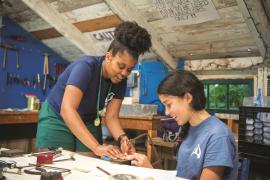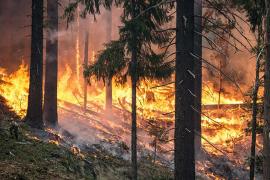Scott Sampson, PhD, is a dinosaur paleontologist, science communicator, and passionate advocate for connecting people with nature. He currently serves as vice president of research and collections and chief curator at the Denver Museum of Nature & Science, where much of his work focuses on rethinking 21st-century cities as places where people and nature thrive. He is perhaps best known as “Dr. Scott,” host and science advisor of the Emmy-nominated PBS KIDS series Dinosaur Train, which airs in more than 100 countries.
You’re a dinosaur paleontologist. What got you interested in the subject of the effects of time in the natural world on kids?
At the age of four I decided I wanted to be a dinosaur paleontologist and I just never grew up. I was a ten-year faculty member at the University of Utah, but it occurred to me that we were at a pivotal moment of history where the decisions we make will impact everything for thousands and tens of thousands of years. So I left a tenured job for no job and wanted to concentrate more on scientific communications.
I consulted with museums and did public speaking around the country. And then an opportunity came up to be the vice president of research and collections at the Denver Museum of Nature & Science. They said, “We’ll give you a chance to walk the talk.”
What drives you?
The question that drives me today and keeps me up at night really is this: What is society’s biggest issue? If you go and ask a hundred scientists right now you’ll get answers like climate change and global warming, but I say it’s the disconnect between humans and nature. You aren’t going to be able to solve those other issues without a connection to the natural world.
You could say who cares. We’re more of a technological world — but all these health conditions (obesity, diabetes, etc.) are dramatically increasing and afflicting people lower in age. Add to that the ecological challenges we have.
So what’s the answer? How do we reconnect people with nature?
How do we re-envision and remake cities as places where nature and people thrive? The only way that happens is if people engage with nature. We have to increase access to nature and the level of engagement through after-school programs and place-based education.
Every city in this country has dozens of organizations actively working in some part of this and have some level of success, but we’re still not moving the needle at the city scale. I would argue that just adding organizations is a failed experiment. The only way to build up the scale is through collaboration.
We’re talking about Denver possibly becoming a model for other cities.
You wrote a booked called How to Raise a Wild Child. Can you explain the premise?
The premise is that the only way kids are going to connect with nature is if we take kids out in nature ourselves.
There are two things kids need to make a connection: abundant time outdoors and a mentor (adult or older mentor) to share in the journey.
It was written as a how-to book for adults to help the children in their lives form a deep connection with nature. It takes a growth-based approach — early childhood to middle adolescence to young adults.
Brains at those ages respond differently.
It also covers how to fold in technology. We need to balance nature and technology
Can you talk a little bit about some of the science behind the need for a human-nature connection?
It turns out to be critical for our physical, mental, and emotional development.
Kids who engage in regular outdoor play have better motor skills and are better able to navigate the world safely with that experience.
Intellectually, kids are more creative. They will play longer in a natural playground as opposed to a metal one because they’re using their creativity. A stick can be a light saber, a writing instrument, etc. They’re actually problem-solving a lot — they’re better understanding the world through play. It’s essential to kid brains.
Emotionally, play in natural spaces reduces bullying. Kids tend to be more social with each other; they tend to play longer and are more engaged. Kids who don’t get nature play are impoverished relative to kids who do.
The impact it has on the trajectory of kids’ lives — it actually causes their brains to grow differently. They’re able to use the world as a place to go and relax. They’re better able to navigate risk when they get older.
The Japanese have found that if they send people out to the forest, it has tremendous recuperative effects. Kids’ lives are pretty stressful these days. Having the ability for them to chill out and relax can be really important to their lives as well. If you want to reduce your stress level, one of the best things you can do is go outside and walk around. Scientists have measured cortisol (also known as the “stress hormone”) levels in the hair and found there is less in those who play in nature.
Your view of nature seems to go beyond what many of us envision at the mention of the word. Can you talk a little bit about that?
Nature is always everywhere around us. There are a 100 trillion cells in our body and a trillion of those cells are not human. There are more living things on your body than there are people on earth.
Many day camps are located in urban areas. Can you talk a little bit about what you consider “urban nature?”
It’s partly just getting aware of what’s there. Whether you’re talking about a summer camp, a school yard, a courtyard, or a planter box on your windowsill, you can “rewild” that place just by planting native plants.
Everything we consume comes from nature. Food comes from nature. Get kids to plant a garden. They’re way more likely to eat vegetables if they plant them themselves.
Shift your focus. Start noticing the little things. Put down a square meter and have them identify everything they can in that space. You can do this in the middle of a field and end up finding a bunch of things.
Get them to look for clouds; have them draw clouds and think about why they are there. That minutia nature and large-scale nature is always there.
If you can make it to a camp ground you’ve got a lot more things at your disposal. You can look for animal tracks, rock formations, etc.
Technology continues to be a hot topic — and how much or how little is needed/healthy. How might camps use technology as an ally?
There are multiple ways. One approach — specifically for kids going out into the wilderness — it’s powerful to unplug for a week. That’s a very powerful, often transformative experience, particularly for teens.
The kids can also use technology some of the time to focus on nature. They can take pictures of nature and create a photo essay.
Download apps that can help the kids identify rocks, plants, and stars.
The key to remember is it’s good to completely unplug some of the time, but also to bolster nature experiences with technology other times. Computers have a wealth of information and can be augmenting.
Looking at screens and being out in nature require different types of attention. In nature, if you turn off the screens, you’re more likely to open up your senses and see more, smell more, hear more — experience the world fully.
It’s really important for people running a camp to find a balance between nature and technology.
When I was a kid we used to spend all of our time outside. Nowadays kids don’t get to do that.
What’s the best way for camp counselors to connect with campers on nature in nature?
Camp counselors don’t need to be experts. They don’t need to know any answers. Questions are way more powerful than answers at sparking wonder in children. You can explore questions and search for the answers together. It’s important to give them permission to not know anything.
Ultimately, our goal is to give kids new experiences in nature, so they notice it, engage with it, and wonder about it.
Just start noticing the nature around you; then let kids truly engage, get muddy, pick up sticks. . . . Nature connection happens through active, bodily engagement. The risks are minimal. If they’ve never had any opportunity to take risks, they won’t be very good at navigating risks when they’re older teens.
Ask kids questions. Get them to talk about their story. What did they see? What did they learn? And adults can tell stories. What was it like to play Kick the Can as a kid? Then they’re going to want to go out and have those experiences as well.
Those are the powerful tools you can use together to foster a nature connection.
Any other advice for camps as to the role they can play in kick-starting a nature revolution?
Two words: fun experiences. The fun element has to be there, and there has to be this experiential thing where you’re pushing limits.
Tie a rope between trees, blindfold kids, and have them navigate by following the rope. Set up stations where they have to use their senses to notice what’s around them. That’s one example of how to create a new experience, to open their senses and experience the world in a different way.
You could do the same kind of thing in a canoe or hiking up a mountain — the key is if you show, as an adult, that you value nature and have fun out in those situations, then kids will too. That’s the most important thing about mentoring.
To camp counselors, I say connecting kids to nature is some of the most important work of our time; it is easy to do, and you don’t need to be intimidated by it.
The real challenge should be keeping that sense of wonder alive. For most kids, it’s beaten out of them by the time they’re ten or 11. Whatever we can do to build that sense of wonder through telling stories, asking questions — that is one of the most important things you can do.
Photos courtesy of Camp John Marc, Bosque County, Texas


